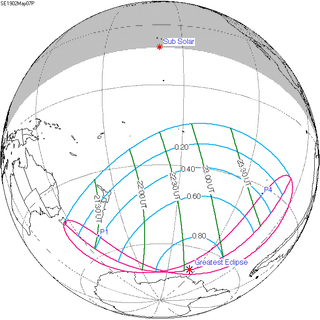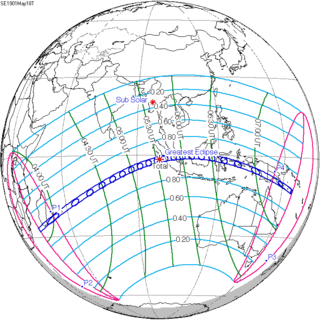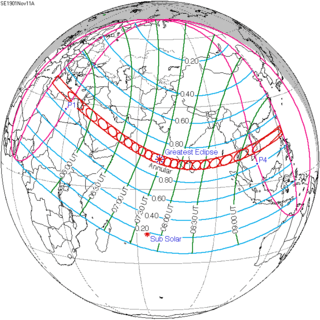Solar eclipse of May 7, 1902
| Solar eclipse of May 7, 1902 | |
|---|---|
 Map | |
| Type of eclipse | |
| Nature | Partial |
| Gamma | -1.0831 |
| Magnitude | 0.8593 |
| Maximum eclipse | |
| Coordinates | 70°00′S 125°06′W / 70°S 125.1°W |
| Times (UTC) | |
| Greatest eclipse | 22:34:16 |
| References | |
| Saros | 146 (21 of 76) |
| Catalog # (SE5000) | 9285 |
A partial solar eclipse occurred on May 7, 1902. A solar eclipse occurs when the Moon passes between Earth and the Sun, thereby totally or partly obscuring the image of the Sun for a viewer on Earth. A partial solar eclipse occurs in the polar regions of the Earth when the center of the Moon's shadow misses the Earth.
Related eclipses
Solar eclipses 1901-1902
Each member in a semester series of solar eclipses repeats approximately every 177 days and 4 hours (a semester) at alternating nodes of the Moon's orbit.
| Descending node | Ascending node | |||
|---|---|---|---|---|
| 136 | May 18, 1901 Total |
141 | November 11, 1901 Annular | |
| 146 | May 7, 1902 Partial |
151 | October 31, 1902 Partial | |
Notes
References
- Earth visibility chart and eclipse statistics Eclipse Predictions by Fred Espenak, NASA/GSFC
External links
| Wikimedia Commons has media related to Solar eclipse of 1902 May 7. |
This article is issued from Wikipedia - version of the 1/15/2016. The text is available under the Creative Commons Attribution/Share Alike but additional terms may apply for the media files.

